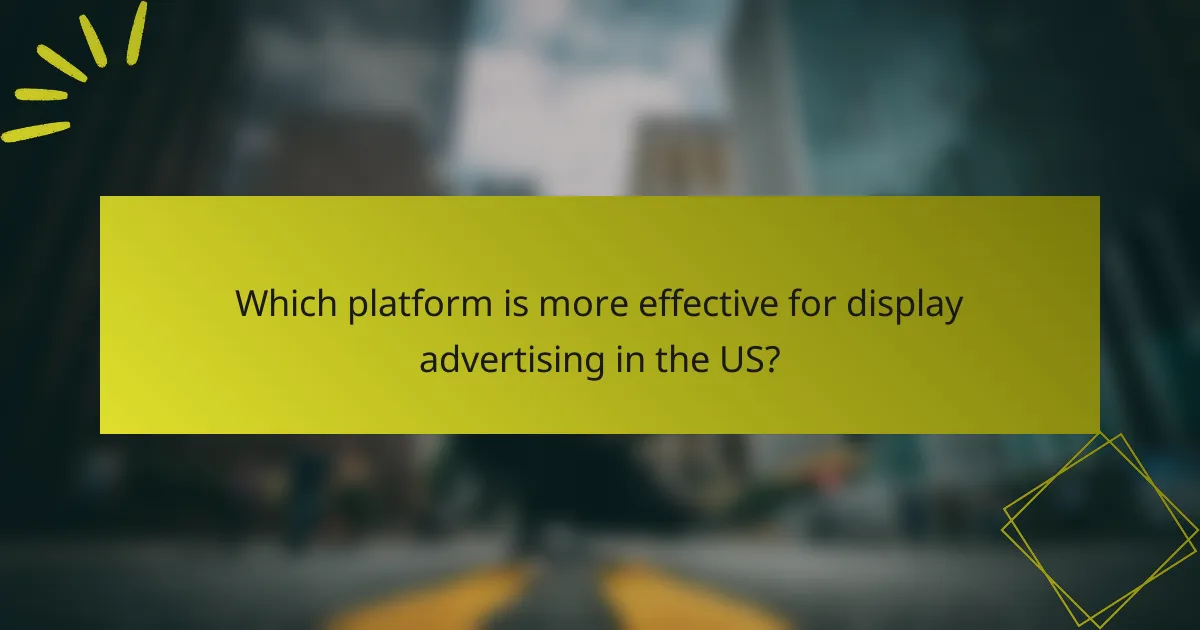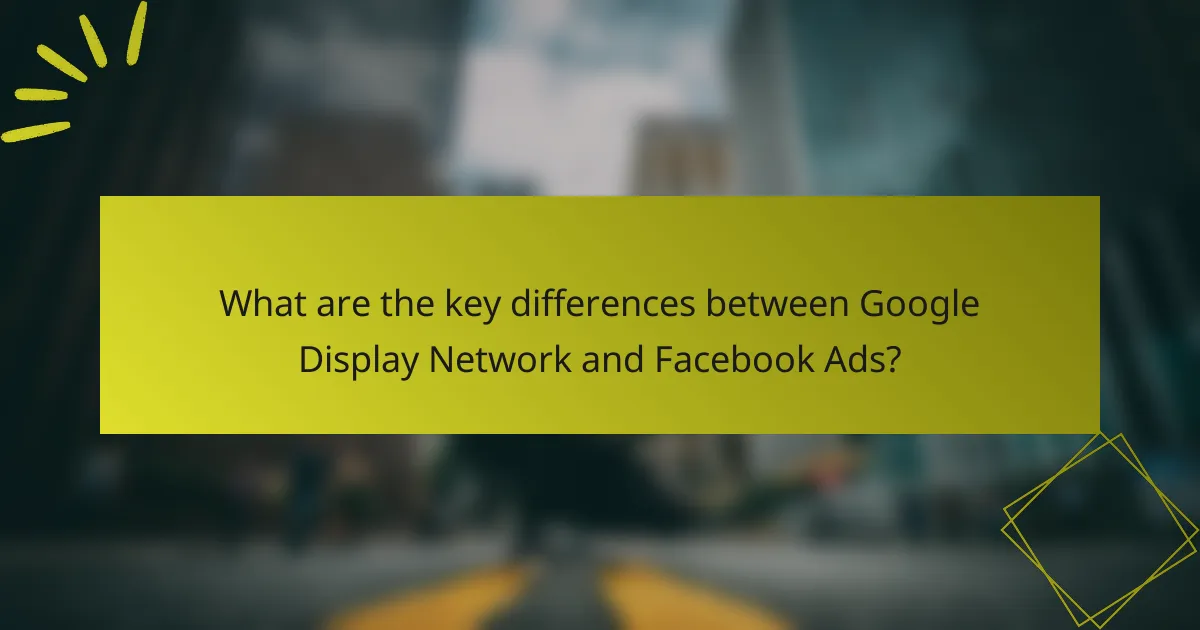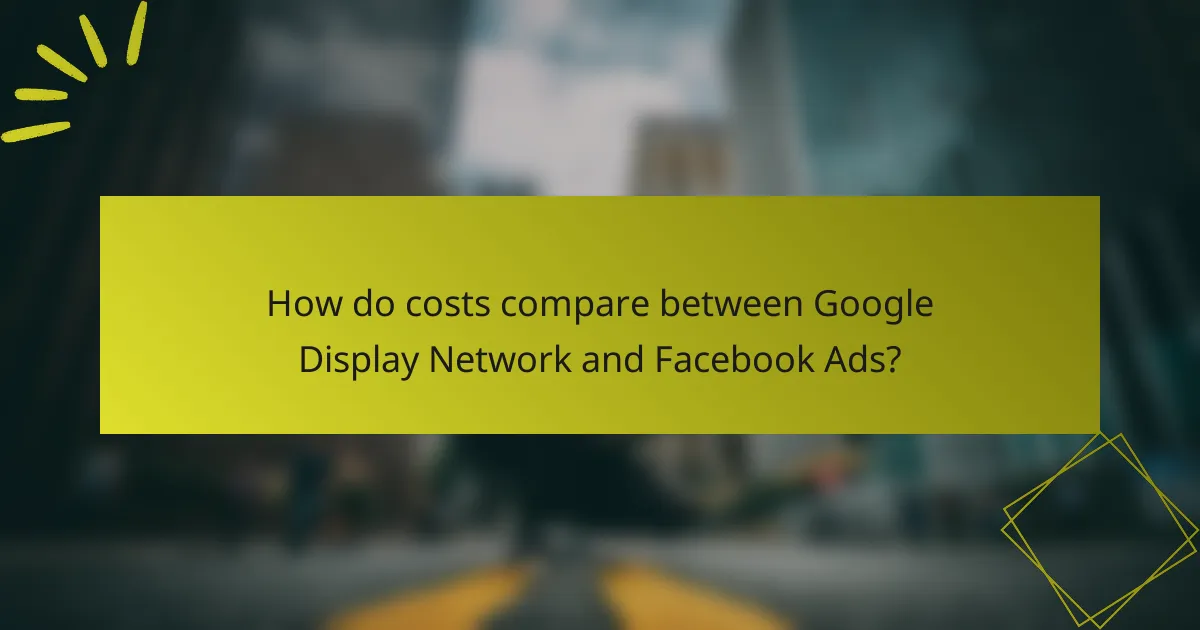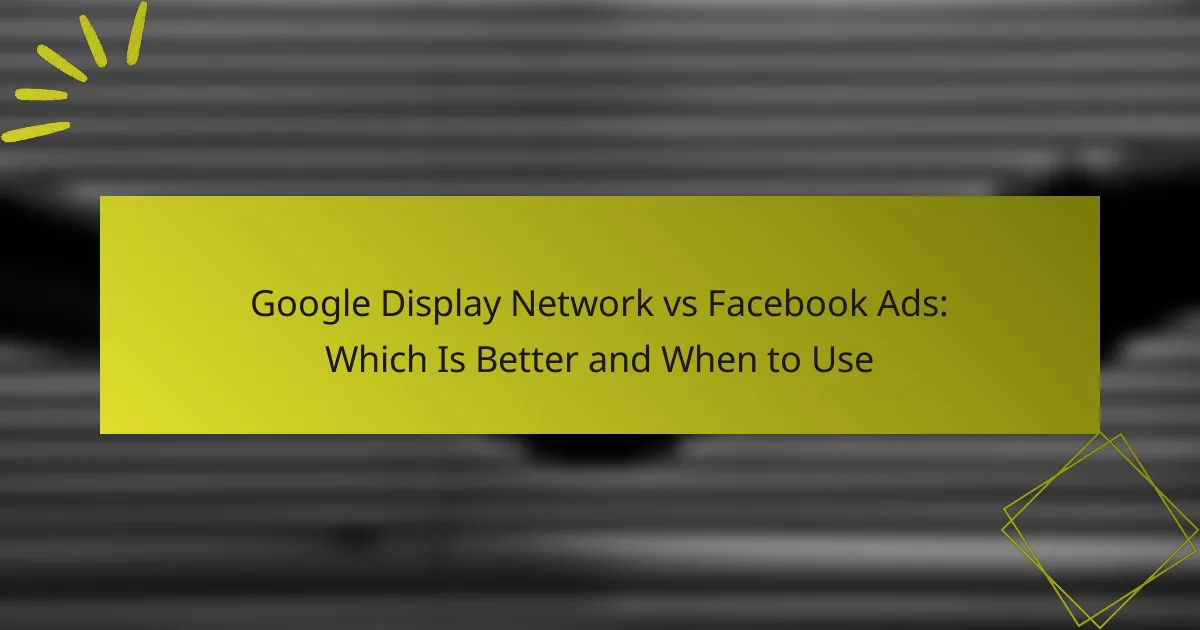When deciding between Google Display Network (GDN) and Facebook Ads, it’s essential to consider your campaign objectives. GDN is ideal for broad reach and brand awareness, while Facebook Ads offers advanced targeting capabilities for engaging specific demographics. Understanding these strengths can help you choose the right platform for your advertising needs.

Which platform is more effective for display advertising in the US?
The effectiveness of display advertising on Google Display Network (GDN) versus Facebook Ads largely depends on your campaign goals. GDN excels in reach, while Facebook Ads shine in targeting precision.
Google Display Network offers extensive reach
Google Display Network provides access to millions of websites, apps, and videos, allowing advertisers to reach a vast audience across the internet. This extensive reach is beneficial for brand awareness campaigns aiming to capture a broad demographic.
When using GDN, consider utilizing responsive display ads, which automatically adjust their size and format to fit various placements. This flexibility can enhance visibility and engagement across different platforms.
Facebook Ads provide superior targeting options
Facebook Ads offer advanced targeting capabilities that allow advertisers to reach specific audiences based on demographics, interests, and behaviors. This precision makes Facebook an ideal choice for campaigns focused on conversions or specific customer segments.
Utilizing custom audiences and lookalike audiences can significantly improve your ad performance on Facebook. By targeting users who have previously interacted with your brand or those similar to your existing customers, you can increase the likelihood of engagement and conversions.

When should I use Google Display Network?
You should use Google Display Network (GDN) when your goal is to reach a wide audience and build brand awareness through visually appealing ads. GDN is effective for campaigns that prioritize visibility and engagement across various websites and apps.
For broad audience reach and brand awareness
The Google Display Network allows advertisers to connect with millions of users across a vast array of websites, making it ideal for campaigns aimed at broad audience reach. By utilizing GDN, brands can increase their visibility and establish a presence in the minds of potential customers.
Consider targeting specific demographics or interests to enhance the effectiveness of your ads. For example, if you’re promoting a new product line, you can reach users who have shown interest in related categories, thereby maximizing your brand exposure.
When promoting visually engaging content
If your campaign features visually striking content, such as videos or infographics, GDN is a suitable platform. The network supports various ad formats, including banners and rich media, which can capture user attention more effectively than text-based ads.
To optimize your visually engaging content, ensure that your ads are designed to be eye-catching and relevant to your target audience. A/B testing different designs can help identify which visuals resonate best, leading to improved engagement rates and conversions.

When is Facebook Ads the better choice?
Facebook Ads is often the better choice when precise demographic targeting and engagement on social media are priorities. Its robust targeting options allow advertisers to reach specific audiences based on interests, behaviors, and demographics.
For precise demographic targeting
Facebook Ads excels in demographic targeting, enabling advertisers to reach users based on age, gender, location, and interests. This level of specificity helps brands connect with their ideal customers more effectively than broader platforms.
For example, a local bakery can target users within a specific radius who are interested in baking or organic food. This targeted approach can lead to higher conversion rates and more efficient ad spend.
When driving engagement on social media
Facebook is inherently a social platform, making it ideal for driving engagement through likes, shares, and comments. Ads can be designed to encourage interaction, fostering a sense of community around a brand.
For instance, a clothing brand can run a campaign featuring user-generated content, prompting customers to share their photos wearing the products. This not only increases engagement but also builds brand loyalty and trust.

What are the key differences between Google Display Network and Facebook Ads?
The Google Display Network (GDN) and Facebook Ads serve different purposes and audiences, impacting their effectiveness based on campaign goals. GDN focuses on visual ads across various websites, while Facebook Ads leverage social interactions to target users based on their interests and behaviors.
Ad placement and visibility
Google Display Network ads appear on a vast range of websites, apps, and videos, allowing for extensive reach across the internet. This placement is ideal for brand awareness and retargeting, as ads can be shown to users who have previously visited your site.
In contrast, Facebook Ads are primarily displayed within the Facebook platform and its associated apps, such as Instagram. This environment allows for more engaging formats, such as carousel ads and video ads, which can capture user attention more effectively.
Targeting capabilities and audience insights
GDN offers targeting options based on keywords, topics, and demographics, allowing advertisers to reach users based on their online behavior and interests. This can be beneficial for campaigns aiming to attract users who are already searching for related products or services.
Facebook Ads excel in audience targeting through detailed user data, including interests, behaviors, and connections. Advertisers can create custom audiences or lookalike audiences, making it easier to reach potential customers who closely resemble existing ones. This level of targeting can lead to higher engagement rates and conversions.

How do costs compare between Google Display Network and Facebook Ads?
The costs associated with Google Display Network (GDN) and Facebook Ads can vary significantly based on targeting, ad formats, and competition. Generally, GDN tends to have lower cost-per-click (CPC) rates, while Facebook Ads may yield a higher return on investment (ROI) for specific niche markets.
Google Display Network typically has lower CPC
Google Display Network usually offers lower CPC rates compared to Facebook Ads, making it an attractive option for advertisers with limited budgets. CPC rates on GDN can range from a few cents to a couple of dollars, depending on the targeting options and competition in the chosen niche.
Advertisers should consider using GDN for brand awareness campaigns or when targeting a broad audience. The lower CPC allows for more impressions and clicks, which can be beneficial for driving traffic to websites or landing pages.
Facebook Ads can have higher ROI for niche markets
Facebook Ads can provide a higher ROI, especially for businesses targeting niche markets. The platform’s advanced targeting capabilities enable advertisers to reach specific demographics, interests, and behaviors, which can lead to more effective ad spend.
For example, businesses selling specialized products may find that Facebook Ads generate more conversions despite higher CPC rates. Advertisers should analyze their target audience and consider using Facebook Ads for campaigns focused on engagement or direct sales to maximize their return.

What metrics should I track for each platform?
When using Google Display Network (GDN) and Facebook Ads, it’s essential to track specific metrics that reflect the performance of each platform. For GDN, focus on impressions and clicks, while for Facebook Ads, prioritize engagement rates and conversions to gauge effectiveness.
Impressions and clicks for Google Display Network
In the Google Display Network, impressions indicate how many times your ads are shown, while clicks measure how many users interacted with them. High impressions with low clicks may suggest that your ads are not compelling enough or are poorly targeted.
To optimize your GDN campaigns, aim for a click-through rate (CTR) in the low to mid-single digits. Regularly analyze your ad placements and adjust targeting settings to improve performance. Consider A/B testing different ad formats and visuals to see what resonates best with your audience.
Engagement rates and conversions for Facebook Ads
For Facebook Ads, engagement rates reflect how users interact with your content, including likes, shares, and comments, while conversions track the number of users who complete a desired action, such as making a purchase. High engagement can lead to increased visibility and lower costs per click.
Monitor your engagement rates closely; aim for rates above 1% as a general benchmark. For conversions, evaluate your sales funnel to identify where users drop off. Utilize Facebook’s pixel to track conversions accurately and retarget users who have shown interest in your products or services.

What are the prerequisites for running successful campaigns on each platform?
To run successful campaigns on the Google Display Network and Facebook Ads, you need a clear understanding of your target audience, a well-defined marketing objective, and a budget that aligns with your goals. Additionally, familiarity with the unique features and tools of each platform is essential for optimizing your campaigns.
Understanding audience segmentation for Facebook Ads
Audience segmentation in Facebook Ads involves dividing your target market into distinct groups based on demographics, interests, and behaviors. This allows you to tailor your messaging and creative to resonate with specific segments, increasing the likelihood of engagement and conversions.
Consider using Facebook’s detailed targeting options, which include age, gender, location, and interests. For example, if you’re promoting a fitness product, you might target users aged 18-35 who have shown interest in health and wellness pages. This precision helps ensure your ads reach the most relevant users.
To effectively segment your audience, start by analyzing your existing customer data and identifying common characteristics. Regularly test different audience segments to refine your targeting strategy and improve campaign performance over time.



